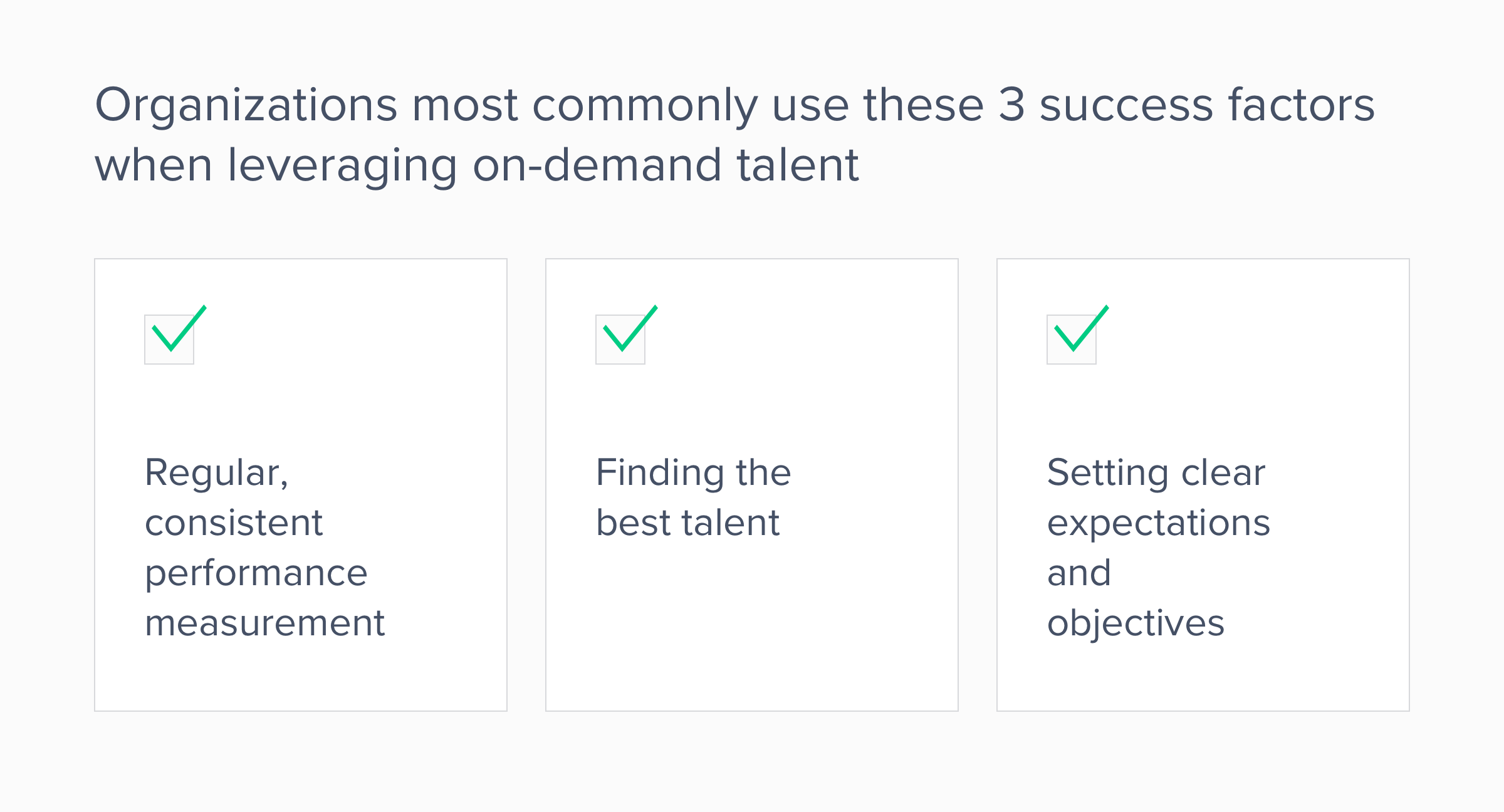Managing and Measuring the Success of On-demand Programs
authors are vetted experts in their fields and write on topics in which they are extremely knowledgeable. All of our content is peer reviewed and validated by world-class professionals.

Agile, empowering, and now pervasive: As the talent economy's growth thunders ahead, enterprises of all sizes are redefining their limitations by partnering with on-demand staffing providers.
Executive assumptions about the contingent workforce are no longer merely outdated; today, shifting labor dynamics are creating entirely new categories of work relationships. Millennials are caught up in the freelance economy, but they're by no means the only catalyst. Some research suggests they trail behind baby boomers, and especially Gen Xers, who are twice as likely to rely solely on independent freelance economy income.
Hiring managers and executives would do well to put aside stereotypes about temporary labor, like reduced outputs, skill limitations, and worker apathy. Google is hiring more contractors than full-time employees, and other companies are moving beyond contributor-level roles, using on-demand talent to fill management and executive positions all the way up to the C-level. And with the global digital transformation underway, skilled freelancers are increasingly working remotely, even on a full-time basis; Toptal's entire employee base is 100% remote, for example.
As these talent models are incorporated widely, companies need to establish parameters for measuring how effective talent programs are in their organizations. Moving towards such programs is an easy maneuver to fumble, so preparation is essential for organizations about to dive into working with on-demand staffing.
Preparing To Use On-demand Talent
To streamline processes involving on-demand talent, it's prudent for executives and managers to first address macro-level questions:
- Which roles should be allowed for on-demand talent?
- Even more broadly, how do we want work to be done at our company, or within our team?
- What are our main motivations for contracting on-demand talent?
- How can we identify knowledge or skill gaps within the company when it comes to engaging and managing talent?
The answers aren't to be set in stone: Working with on-demand staffing means that these considerations can and should depend on medium-term strategies. Implementing a cycle to ensure these questions are revisited is key to the sustainability of an on-demand talent program.
C-suite Visibility
Hiring managers can't force C-levels to care, but they might show that it's in their best interests to have an opinion about on-demand talent. In this new talent economy, crucial work is performed by skilled experts who want to be doing it and have chosen freelance employment, in contrast to traditional temp labor models. These experts can be key in massively amplifying an organization’s efforts.
Moreover, some executives use talent-based labor models as a viable cloaking strategy: It allows them to maintain headcount freezes while simultaneously pushing projects ahead where they need more performance.
A good starting point for obtaining C-level visibility is to look collectively at overall projects by going into business units and learning about their engagement with contingent workers of various types. It's critical to define categories here. For example, it's important to know exactly who counts as a contractor versus an independent vendor providing services—a distinction that will inevitably vary by region. With that resolved, companies can move on to scanning every last department—both for clarity and for ensuring compliance. This is a point on which many companies need challenging.
Once the mystery is gone, better management can begin.
Buzzword Check: “Total Talent Management”
Sometimes inventorying is done under the umbrella of total talent management, with the sense that a company isn't really a company without it—the same way tech companies might nowadays chase AI or blockchain strategies more for “street cred” than for anything else.
Whatever terminology a company uses, the point is for higher-ups to get a handle on how and why they're using contingent workforce strategies in various capacities in order to use it as effectively as possible—and to avoid the risks of its misuse.
Executives can use their increased perception to start delving deeper into contingent workforce use. Sometimes patterns are as they should be; contingent (or full-time) labor may be in use simply because it's always been that way. Is that really the best approach moving forward for the work in question? Looking at the work holistically, which parts of it can be done by a full-time employee? What can be done by traditional staff augmentation on-site? What can be performed by a freelancer whose physical location is not as important?
When answering these questions reveals a need for additional talent—whether immediately or on a foreseen tactical basis—the next issue is organizing a company's source(s) of talent. In many cases, rejigging the organization’s approach to its talent network is warranted.
A Talent Network Wasn't Built in a Day
It may be effective on some levels to use word-of-mouth to find talent, and experience to determine which relationships are worth maintaining. But that's provided a company started executing this strategy years prior.
It also requires that the company properly tracked the results across all business units, otherwise the data will be inconsistent and unactionable. For example, one department firing someone with good reason would be potentially ignorant of another department rehiring them. And institutional knowledge of particular positive or negative experiences may have been lost with employee turnover.
Many companies lack established, well-managed talent networks of their own; if they endeavor to build one, it will take time. In this case, using a talent provider—or managing their own roster of on-demand staffing providers, depending on needs and scale—lets an organization leapfrog this requirement by efficiently tapping into existing talent pools.
Three Internal Prep-steps
It's not time to hire just yet. With a talent network in place, the success of a talent program will hinge on whether the company makes appropriate preparations.
Address Internal Politics
Anticipating and heading off unhelpful attitudes toward incoming talent is crucial. Without this step, full-time staff can effectively sabotage the efforts of contingent workers.
Why? Because permanent employees who perceive that their roles might be outsourced will naturally react defensively and with resentment. Executives may even have their own concerns.
It's best to allay fears by being up front about a company's talent strategy and emphasizing the particular benefits that come with it, be they flexibility, reduced time-to-market, expertise injection, customer satisfaction, or some other key angle.
Collaboration is maximized when full-time workers, management, and executives alike are able to genuinely welcome agile talent into their projects. A warm welcome won't make up for a poor onboarding experience, though.
Create Effective Onboarding Experiences
This critical piece of preparation can vary among organizations, but it's considered a bare minimum to introduce talent not only to project specifics but also their wider context, setting expectations on how the team works in the process. With that their work can be meaningful, but detailed attention must be paid to dependencies, otherwise it's a moot point.
Some organizations take two weeks just to get new hires a laptop, and their IT departments think that's a perfectly acceptable SLA.
– Rory Spanier, Client Partner - Staffing Programs and Compliance
Whether it takes HR policies or IT KPIs to sort out wrinkles will depend on company specifics.
The bottom line is, a clear vision for how and why to engage with a given type of talent is a solid starting point for any organization doing so. What may be more difficult to clarify is who should be responsible for supporting and managing a talent program. Fortunately, the decision there has the potential to avoid traditional power struggles like “HR versus procurement” and turn them into opportunities for collaboration.
Build a Cross-functional Team
Building an internal, cross-functional support team is fundamental to assembling a skilled contingent workforce strategy. HR, procurement, law, finance, and the business teams all have key stakes, responsibilities, and competencies to contribute within a successful program. Involving them all is also the only way to keep metrics like “cost to hire” comprehensively accurate.
The best-run programs are jointly run by HR and procurement because both HR and procurement bring unique skillsets.
– Brian Hoffmeyer, SVP of Market Strategies (Beeline)
HR is often adept at dealing with people in the talent sphere, whereas procurement excels at managing contractors, suppliers, and the like. But both of these angles are pivotal for on-demand programs, especially when company strategy involves sourcing from talent providers.
But what can companies do to promote positive talent outcomes, once these other pieces are in place?
Working with On-demand Talent
On-demand staffing contracts are often inherently temporary. Despite this, the relationship between a company and the on-demand talent that they engage is quite important. In the short term, it's key to a successful outcome, but a successful outcome is itself key to future successes.
It may require a shift in mindset, but viewing a talent engagement as a partnership—however transitory it may be—carries two very worthwhile benefits.
Establish a win/win partnership relationship with agile talent, one where both parties feel a stake in one another’s success.
– Harvard Business Review
Morale and motivation are at least as important as money for many in the freelance economy. Treating talent as partners enables them to accomplish more from within their role. It also opens the door to fruitful exchanges of expertise: Companies can coach and mentor talent, and also expect them to share their know-how with team members, adding value to the impact they leave when their contracts end.
In terms of company process, there are two aspects to pay attention to. First, it's worth gathering feedback from everyone affected by the actions of on-demand talent. This is dynamic and depends on what opportunities are extended to talent within their roles.
Second, a periodic review by the above cross-functional team of the wider picture of talent interactions is essential. This gives the team the opportunity to put their learning points into action and continually improve the program with each cycle.
It's not just qualitative feedback that's important, though. Quantitative data needs to be considered, and the central question is, “What should we be measuring?”
Measuring Talent Effectiveness
According to Toptal's annual State of the Workforce survey, most organizations cite three success factors in common for using on-demand talent effectively.

But what does it look like for a company to measure success from particular on-demand talent?
“Is My On-demand Talent Quality Talent?”
Work quality is not the only aspect of interest here, but it's certainly important. A convenient way to measure quality here is to leverage existing QA processes: Are checkpoints satisfied sooner (versus full-time labor and other talent), or is rework required often? Are colleagues having to clean up after talent, or do talent raise the bar within their teams? Do they fit the company culture, or is there unexpected conflict over basic assumptions?
At a broader level, monitoring the frequency of contract extensions gives some indicator of talent quality, but since there may be other factors involved (talent availability, for one), relying on this alone is considered a pitfall.
Often employers are loath to rate contractors in general, because they think it exposes them to additional co-employment risk, but that's a misconception. Companies naturally need to measure effectiveness, regardless of employment category.
While current VMS processes don't cover rating talent and tracking feedback from hiring managers, handling this is part of the value proposition of talent providers.
The talent quality question is obviously valid, but it's not the only one. A well-run on-demand staffing program also measures talent providers as well as the enterprise itself.
Setting Worthwhile KPIs
Put simply, to attract high-quality candidates, you need to run a high-quality program. And to run a high-quality program, you need to establish and track smart metrics from top to bottom.
– Taylor Ramchandani, VectorVMS
The following table is a starting point for creating a set of smart metrics. Optimizing for a static set of KPIs will prove counterproductive, especially in the long run. To ensure alignment with a company's current situation and tactical goals, best practices call for a periodic or continual reevaluation of KPI selection—not necessarily a continual expansion.
| Whose Performance? | Whose Tracking/Analysis? | ||||||
|---|---|---|---|---|---|---|---|
| KPI | Talent | Talent Provider | Direct Manager | Hiring Manager | HR | Procurement | Hiring Manager |
| Contract extensions | ✅ | ✅ | ✅ | ✅ | |||
| Talent retention vs rate of talent leaving the business early (positive or negative reason) | ✅ | ✅ | ✅ | ✅ | |||
| Onboarding and project milestones/completion | ✅ | ✅ | ✅ | ✅ | ✅ | ||
| Billable hours, total cost per billable hour | ✅ | ✅ | ✅ | ||||
| Time to hire, time to fill | ✅ | ✅ | ✅ | ||||
| Cost per project (cf. similar work both organization-wide and by full-time employees) | ✅ | ✅ | ✅ | ✅ | ✅ | ||
| Talent rating and feedback from hiring manager | ✅ | ✅ | ✅ | ✅ | |||
| Reengagement of on-demand talent | ✅ | ✅ | ✅ | ✅ | ✅ | ||
| Risk costs and compliance savings | ✅ | ✅ | ✅ | ✅ | ✅ | ✅ | |
| Background screening and documentation compliance pass rates | ✅ | ✅ | ✅ | ||||
| Start date compliance (“false start indicator”) | ✅ | ✅ | ✅ | ✅ | |||
| Talent provider response time | ✅ | ✅ | |||||
| Executive team satisfaction | ✅ | ✅ | ✅ | ✅ | ✅ | ✅ | ✅ |
| Worker satisfaction | ✅ | ✅ | ✅ | ||||
| Interview-to-fill ratio, submission-to-fill ratio | ✅ | ✅ | ✅ | ✅ | |||
| Hiring manager response time and decision time | ✅ | ✅ | ✅ | ||||
| Number of submissions, hiring rate | ✅ | ✅ | ✅ | ||||
| Job description rewrite rate | ✅ | ✅ | |||||
| Ratio of project completion time to projected time | ✅ | ✅ | ✅ | ✅ | ✅ | ||
| Audit compliance rates | ✅ | ✅ | ✅ | ✅ | ✅ | ||
| Evaluation efficiency | ✅ | ✅ | ✅ | ✅ | |||
| Candidate qualification accuracy | ✅ | ✅ | ✅ | ||||
| Invoicing and payment efficiency | ✅ | ✅ | ✅ | ||||
| Hiring managers' NPS of the program* | ✅ | ✅ | ✅ | ✅ | |||
| Hiring managers' NPS of the talent* | ✅ | ✅ | ✅ | ✅ | |||
| Talent's NPS of the client* | ✅ | ✅ | ✅ | ✅ | ✅ | ||
| Talent's NPS of the talent provider* | ✅ | ✅ | |||||
| Company's NPS of the talent provider* | ✅ | ✅ | |||||
* Talent economy emerging KPIs. The remaining items are traditional KPIs.
Creative KPI variations can have merit here. By splitting processes timelines into many different checkpoints, management can become as targeted as needed. Likewise, internal costs can also be broken down further by department and type, if the program is monetarily weighty but otherwise successful.
Tactical measures themselves need to be well-thought-out. One common mistake is for a company to measure project completion time without factoring in its own shifting requirements (e.g., feature creep—adding new features or capabilities while a project is in-flight). As a result, it could lose high-quality talent to what's essentially a mis-measurement.
Some KPIs can be correlated to multiple subjects. Suppose talent who terminate contracts early tend to come from the same talent provider or tend to be managed by the same individual. This could highlight an avenue for further inquiry and action—perhaps emphasizing other talent providers, or providing coaching to a particular manager.
But such interpretations may also invalidate earlier, isolated evaluations of a talent’s scorecards. It's worth scrutinizing the flexibility of a company's management systems; not all of them can accurately handle cases like this.
Not all goals will be easy to find KPIs for: Suppose a company is expecting on-demand talent to help modernize their techniques and approaches. It may be as simple as converting qualitative data to quantitative via an NPS-based approach, or by periodically contracting an outside evaluation. It's up to the company to decide on the most appropriate way to capture what's important to them here.
Whatever KPIs are selected, pursuing them is subject to constraint trinities. For example, talent programs can hardly be considered successful if they minimize time but result in failure, re-work, and/or having to find more talent.
Measuring On-demand Talent: Tactics Change Alongside Your Business Goals
A well-designed on-demand staffing program can spark, and will thrive on, alignment across an enterprise. The talent economy continues to bloom, with industry giants like Google among those leveraging it in new ways. On-demand staffing programs will become the new differentiating factor among competitors: How adept a company is at keeping its talent program as agile as the workforce it's leveraging.
Special thanks to Brian Hoffmeyer (SVP of Market Strategies at Beeline) and Rory Spanier (Client Partner - Staffing Programs and Compliance at Toptal) for sharing their industry experience for this article.
